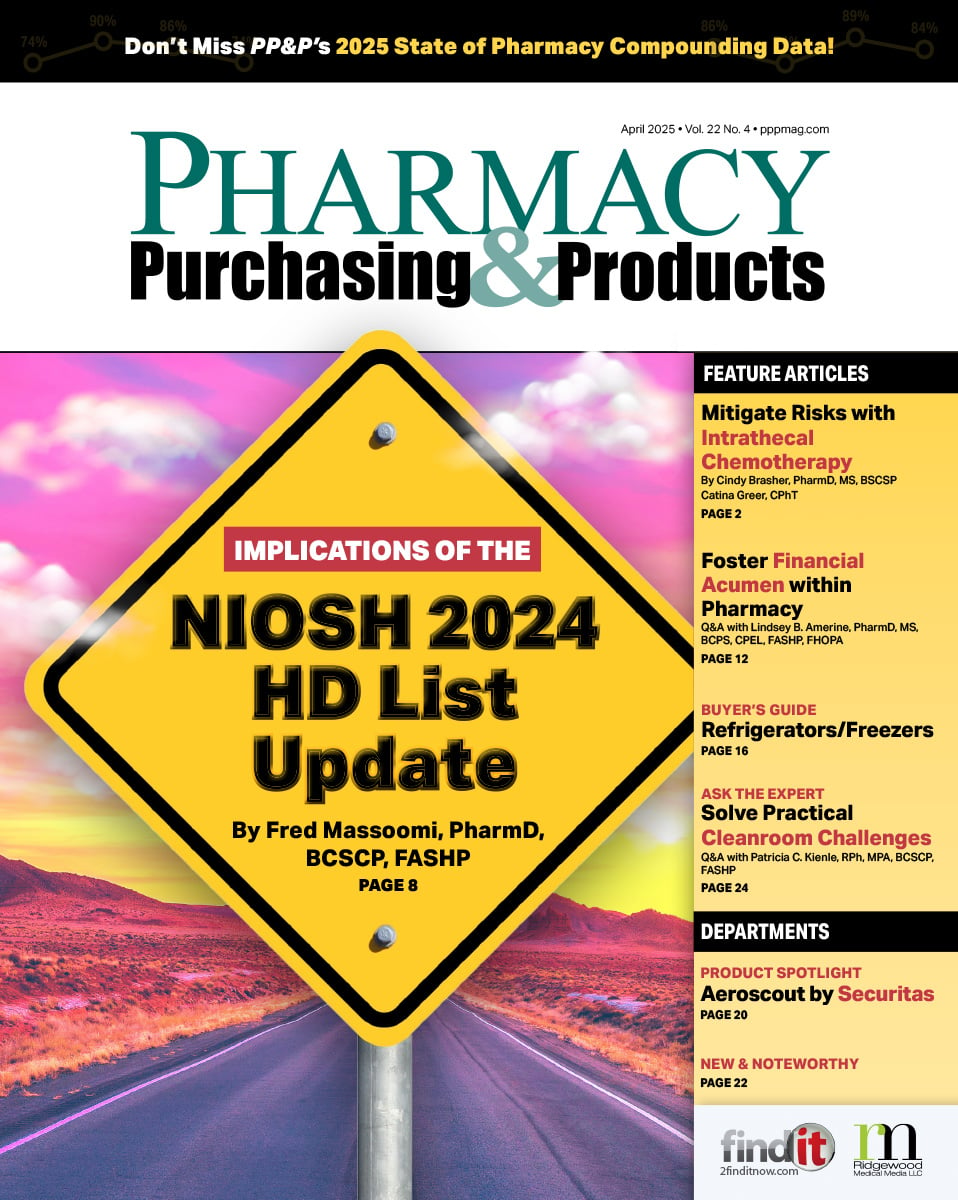- Show Menu
- Contact Us
- FAQs
- Reader Service
- Survey Data
- Survey Winners
- Testimonials
- Upcoming Events
- Webinars
- White Papers
Capitalize on 340B Software Reporting
As technology continues to drive more aspects of our lives, it is easy to see the value in relying on automation to assist with day-to-day activities. In the pharmacy, automation and technology are commonly employed to simplify medication management. With 340B, for example, software serves as a vital tool to utilize the 340B drug-pricing program to its full potential while also ensuring compliance with the critical requirements.
Administered by the Office of Pharmacy Affairs (OPA) under the US Health Resources and Services Administration (HRSA), the 340B program allows eligible entities to purchase drugs at a discount. Eligibility rules for 340B require that an entity meet certain qualifications, eg, treat a disproportionate number of indigent patients and adhere to the guidelines outlined by HRSA. Covered entities are subject to HRSA and manufacturer audits to ensure program integrity; failure to comply can result in removal from the program.
As health care becomes increasingly information-driven, ensuring 340B compliance is more challenging to achieve through dedicated personnel alone. In 2016, 199 audits were conducted; 138 of these had adverse findings.1 In response to this increased scrutiny, many entities are implementing software to assist in managing their 340B programs.
Capital Health’s 340B Approach
Capital Health Regional Medical Center (CHRMC), a 200-bed disproportionate share hospital (DSH) located in Trenton, New Jersey, includes a comprehensive stroke center, a level II trauma center, emergency mental health services, and neurologic emergency medicine. CHRMC is a teaching hospital that is committed to providing quality health care to all patients regardless of their ability to pay. The 340B program is integral to CHRMC’s capacity to provide care for the community’s most vulnerable patients.
To ensure compliance with the regulations of this critical program, CHRMC implemented 340B software in 2015. The software uses an algorithm to help determine if drug usages are 340B-eligible and provides data to the entity to split purchase orders into the correct accounts. The software’s data and reporting capabilities are utilized to manage 340B requirements and to enhance financial management in other ways. Reports generated by the software assemble useful wholesaler and hospital data to help coordinate 340B drug ordering and facilitate the sharing of financial data with hospital administration.
The Implementation Process
Two teams, one from our software vendor and one comprising CHRMC staff, led the initiative to implement the software. The vendor’s team set up the data structure, while the hospital’s key stakeholders were responsible for building the database and ensuring a properly linked infrastructure.
When implementing 340B software, it is vital to identify and involve hospital staff from the beginning. The director of pharmacy and hospital administration should be actively involved to facilitate access to the resources required for proper management and oversight of the implementation. Depending on the entity’s size and configuration, at least one IT professional, an IT pharmacist, and the organization’s 340B coordinator should be included in the core group. Depending on the group’s knowledge and experience, hiring a consultant to assist with the project may prove beneficial.
The implementation process requires at least a 2- to 3-month time commitment; the time frame will vary depending on the responsiveness of the teams and the complexity of the entity’s 340B program. The type of data feeds set up can be as detailed as the entity desires. Carefully consider which data feeds to include in the beginning, because making changes during or after implementation can extend the time frame and/or affect the software’s performance. The main data feeds that should be captured and tested for accuracy include drug utilization, patient visits, admission/discharge/transfer (ADT), and wholesaler purchasing data (see FIGURE 1).
Effective communication among team members throughout the implementation process is critical to facilitate the project’s quality and efficiency. The 340B coordinator should be the main contact between the vendor and the pharmacy, and respond to every inquiry in a timely manner. All decisions and requests made in regard to the software implementation should involve the dedicated 340B hospital personnel.
After go-live, the software must be monitored and maintained on a daily basis, as the accuracy of the reports relies heavily on the software performing as intended. When properly monitored and maintained, the pharmacy director and 340B coordinator can rely on this data as a guide for 340B compliance and decision-making.

Regularly Generated Reports
340B-Specific Reports
CHRMC generates the following 340B-specific reports to ensure proper program management and cost savings:
- Qualified and Nonqualified Utilization. The qualified utilization report displays all 340B-qualified medication utilization for a specified date range and can be used to verify that the software’s algorithm is performing correctly. The nonqualified utilization report is similar, but also displays non-340B-qualified utilization. Samples are drawn from both reports for internal auditing purposes.
- Purchases-by-Account. This report displays purchase information for all accounts managed with the 340B software and is useful for identifying purchasing trends for specific time frames. CHRMC uses purchases-by-account to extract the amount spent on each account when providing updates to hospital leadership. The report assists in identifying any purchasing surges on the wholesale acquisition cost (WAC) account due to any overlooked issues. The 340B, GPO, and WAC pricing can be listed with each item purchased to determine the impact of purchasing changes.
- Top-Dollar Spent Items by NDC. This report delineates the most expensive purchases by selected time frame. The amounts are calculated from all accounts using the actual purchase cost. Pharmacy can review the types of medications stocked with the highest costs and identify the type of patients or medical conditions that require the most resources.
- Various Savings Reports. The 340B software generates multiple savings reports, which are the most influential when demonstrating the value of the 340B program to leadership. Pharmacy reviews this data for accuracy and then performs an additional calculation to compare the costs of the same items purchased on the 340B, WAC, and GPO accounts.
CHRMC routinely generates an executive report that summarizes our purchasing, auditing, and financial savings information (see FIGURE 2). This is sent to the director of pharmacy, vice president, chief financial officer, and chief compliance officer for review. This process increases program integrity and generates awareness of the benefits of 340B, which helps gain hospital leadership buy-in to support the program.
Supplemental Financial Reports
Additional software reports are utilized for both 340B compliance and to improve general financial management. This data has proven to be accurate and easy to use compared with data generated from other sources (eg, wholesaler purchasing reports, hospital billing information, etc) and include the following:
- Pricing Report. This list of the current pricing of all items in the NDC for 340B, GPO, and WAC accounts can also be abbreviated to only include NDCs that are matched in the NDC-CDM crosswalk. Pricing reports should be generated every quarter; these assist the buyer in monitoring price changes to determine if the current purchasing pattern requires modification.
- Charges by CDM. By displaying hospital utilization and types of charges for selected dates, this report can be used to review and detect variances in charging patterns, which may indicate a change in how the drug is charged or possible errors during the profiling stage. Depending on the findings, the 340B coordinator may need to adjust the billing units per package and communicate with the IT pharmacist to make similar adjustments in the profiling/charging procedure—for example, charging by vial rather than by milligram. It is helpful for the director of pharmacy and clinical pharmacists to review formulary drugs against this data, along with the purchasing report, to assist in decision-making.
As part of this process, we also monitor inpatient and outpatient antibiotic usage on a monthly basis to ensure compliance with the Joint Commission-mandated antibiotic stewardship standard.
- The Crosswalk Gap. This report lists potential utilization gaps in the NDC-CDM crosswalk and helps identify any utilization that was not associated with an NDC. The missed utilization can help differentiate between a WAC and a non-WAC purchase.
- Patient Type Change Verification. This report lists charges that were submitted as one type of qualification (inpatient/outpatient) and later switched to another due to ADT information. When generated regularly, this helps to verify that charges are categorized correctly. Since patient type directly affects the accumulation amounts on a daily basis, it is important to continuously monitor utilizations that are switched and compare them with the ADT report to verify accuracy.
- Accumulation. This report lists the current accumulation amount for each NDC per account, as well as the last time the NDC was purchased on each account. By comparing the accumulation quantity against the last time the same NDC drug was purchased, we can determine if there is an error in the crosswalk and prevent unnecessary WAC purchases. This data directly affects the accumulation quantity and should be monitored regularly to quickly identify and resolve any errors.
Ensuring Compliance
Simply managing the volume of data that flows through a health care organization can be intimidating; this is particularly true when the goal is to meet HRSA’s compliance requirements for the 340B program. Using the reporting features of our 340B software program as a tool, we are able to better monitor activities and identify errors. In addition, these features save time and help proactively maintain compliance by enabling us to expand auditing; monitor purchasing habits; and review, identify, and correct errors in our systems and procedures. In the event of a HRSA audit, we can easily access the requested data and then describe how the data is used to identify issues and perform corrective actions. This capability significantly increases our confidence in remaining compliant with the intent of 340B.
Conclusion
The 340B program is an important asset for health care delivery; thus, ensuring compliance and maintaining program integrity are paramount for all covered entities. Gaining buy-in from administration is a key step to ensure the program’s continuation. Depending on the size of the covered entities, the number of child sites, outpatient department activities, and the number of contract pharmacies, an investment in pharmacists or technicians to manage the program should be part of the compliance effort.
The adoption of 340B software should occur in collaboration with experienced staff and/or a knowledgeable consultant. With the software in place, the 340B coordinator can generate monthly reports detailing the entity’s financial savings and compliance status and present this information to pharmacy and hospital leadership. This data can be a powerful tool in protecting access to the 340B program and ensuring the continued care of vulnerable patients.
References
- Health Resources & Services Administration. Program Integrity: FY16 Audit Results. www.hrsa.gov/opa/program-integrity/audit-results/fy-16-results.html. Accessed October 2, 2017.

Chester Lau, MS, is the director of pharmacy at Capital Health Regional Medical Center in Trenton, New Jersey, and Capital Health Medical Center in Hopewell, New Jersey. He received his BS in pharmacy from Rutgers University in 1976 and his MS in clinical pharmacy from St. Johns University in 1980. Chester lectures to pharmacy students at his alma mater and serves as a preceptor for pharmacy residents and APPE students. He has received the Preceptor of the Year award from USP and the Excellence in Innovation award from NJPhA.

Elli Kim, BS, CPhT, is the 340B program coordinator at Capital Health Regional Medical Center and Capital Health Medical Center. She received her BS in accounting from Rider University in 2011 and obtained her CPhT the same year. As the main contact within the entity for all matters regarding 340B, she is responsible for maintaining compliance for the 340B program in addition to providing input and assistance for internal stakeholders when planning new services and programs.
Like what you've read? Please log in or create a free account to enjoy more of what www.pppmag.com has to offer.








